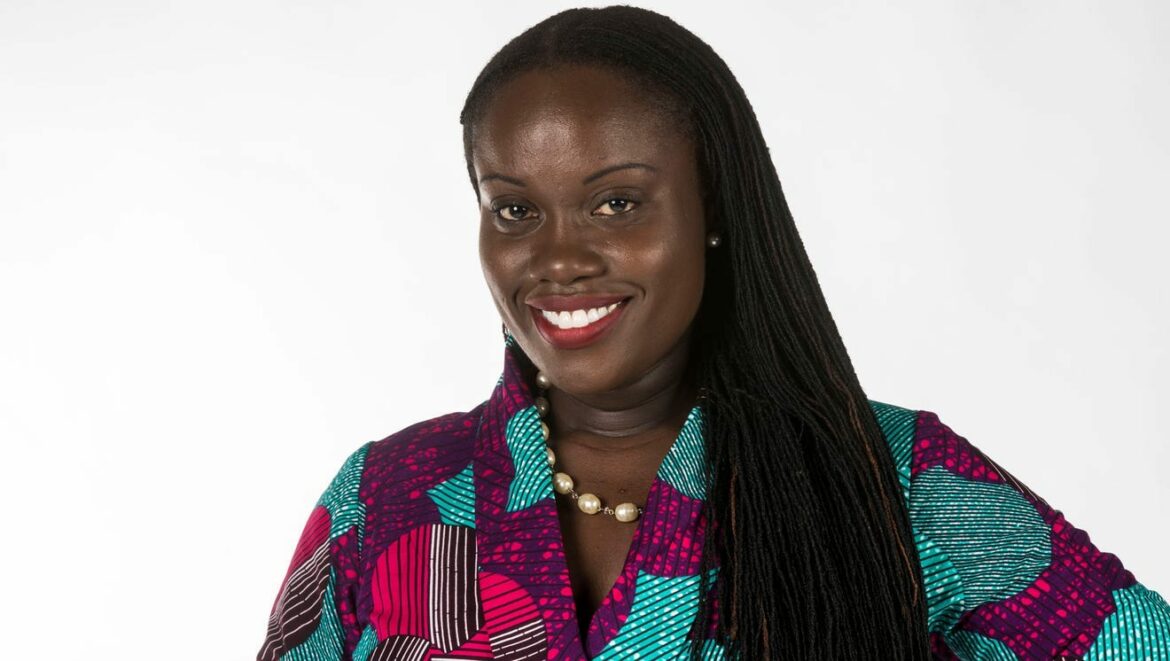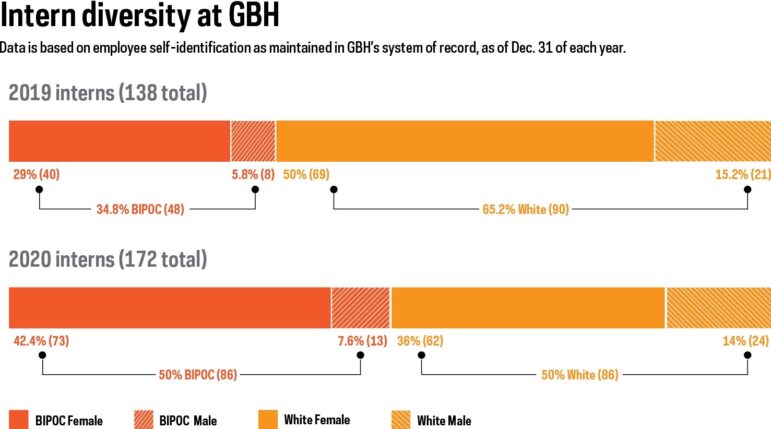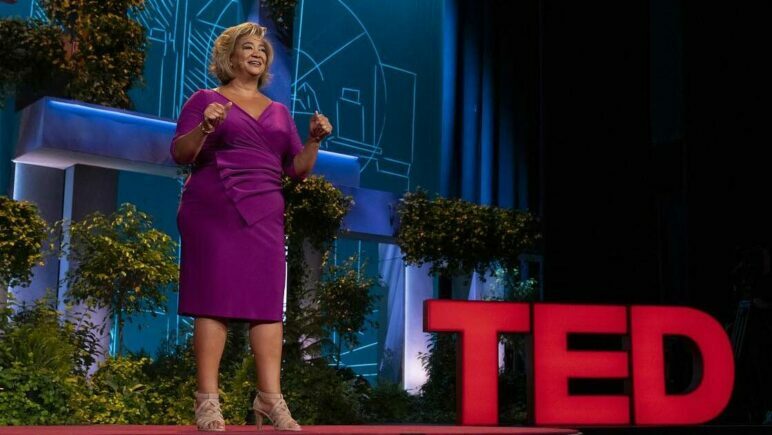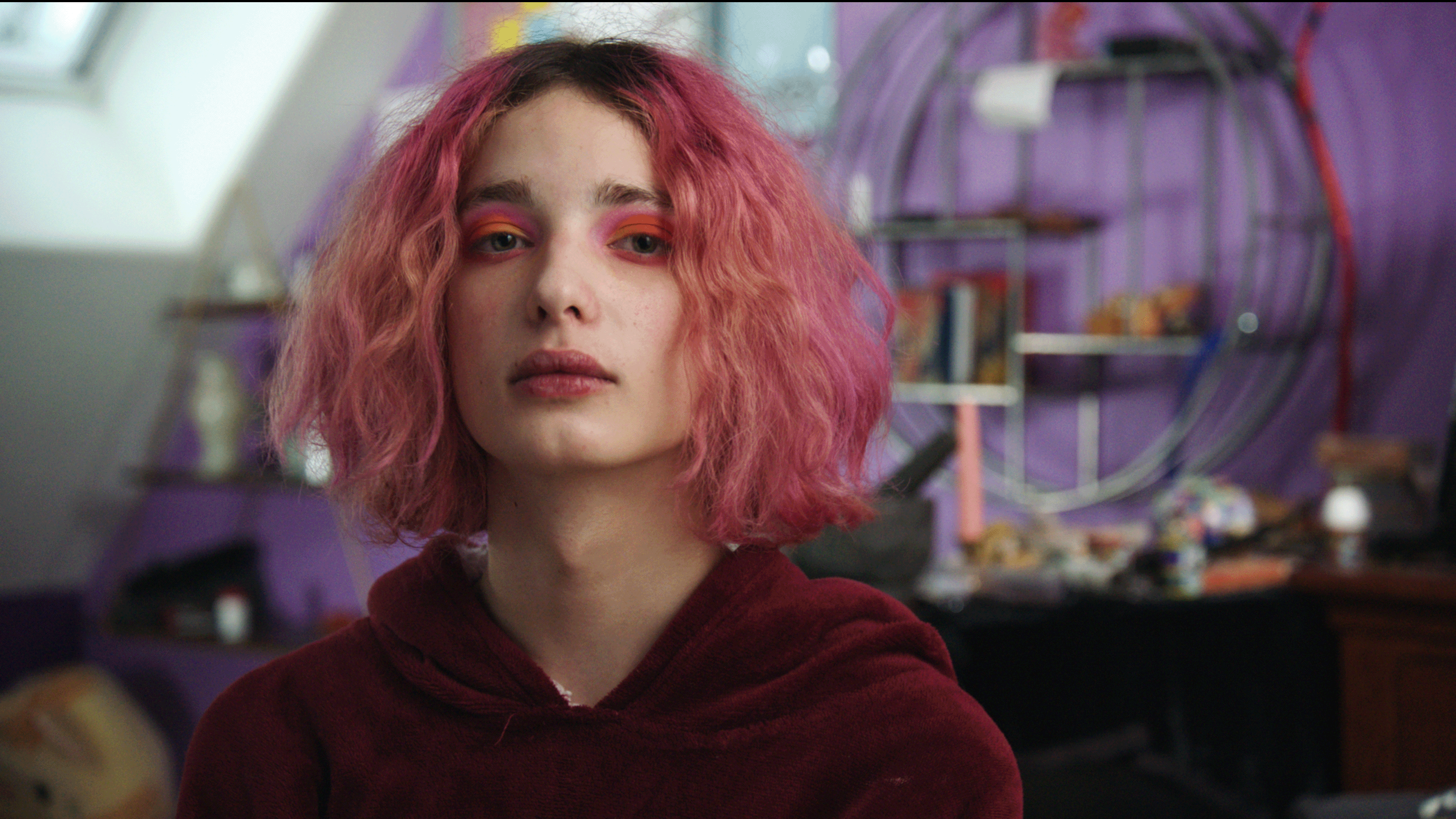How GBH’s inclusion and equity officer is rolling out her four-phase plan for DEI work

Andrea Melendez / USA TODAY NETWORK
Oloruntola-Coates
Since the summer of 2020, diversity, equity and inclusion officers have been joining public media at a steady clip, carving out new roles and strategies for stations and national organizations to improve their workplace cultures and service to communities.
Yemisi Oloruntola-Coates became chief inclusion and equity officer of Boston’s GBH in May 2021. It’s her first job in public media, but she says GBH’s focus on community service is similar to that of her previous employers, including Baystate Health, a nonprofit serving western Massachusetts. Oloruntola-Coates describes herself as an “inclusion architect” because she specializes in using data to design and build inclusion strategies for workplaces and public-service institutions.
In a recent interview, Oloruntola-Coates spoke with Current’s Julian Wyllie about what she has learned during her first months with GBH, how her new role compares to her previous jobs, and how she has structured DEI work at the station. This transcript has been edited for clarity and length.
Current: Before you joined GBH, you had worked for two healthcare systems as a DEI leader. What made you want to join the station?
Yemisi Oloruntola-Coates: I call myself an inclusion architect because I enjoy building and designing DEIA strategies. I was excited about the opportunity to build something new at GBH.
Current: I noticed that you added an “A” to the acronym for diversity, equity and inclusion. What does the “A” stand for and what does it mean for the work you’re doing at GBH?
Oloruntola-Coates: The “A” stands for accessibility. GBH created closed captioning for television programs, innovating to make TV accessible for people who are deaf or hard-of-hearing. Whenever you focus on reaching a community where there are barriers to access, it actually has a wider impact.
Closed captioning helps people who are learning English for the first time. They’re able to hear the sound and see the word. Closed captioning helps people who are watching TV in a loud, busy environment; they can’t hear the dialogue but they can read it. Closed captioning also helps those who have learning disabilities. So there’s a lot of functionality around accessibility. There’s accessibility in terms of GBH’s products. There’s also accessibility as it relates to our people, our employees.
Current: How did your previous jobs in DEI prepare you for your role at GBH?
Oloruntola-Coates: Working in public health, I learned that data drives interventions and it is also people-focused. I believe that my strong emphasis in research and data is an add to public media. However, public health and public media have one thing in common — the connection to the communities they serve. That knowledge and understanding has prepared me for this role.
Current: How would you compare the DEI work from your previous jobs to GBH?
Oloruntola-Coates: In the public media space, GBH is one of the largest. But I’ve worked in larger organizations, as large as 20,000 employees, so I’m used to working in large integrated systems. Even though they were big, they were nonprofits. Like GBH, they focused on serving communities and people.
Obviously the products are different. Working in public health, I was dealing with science, medicine and patient care. In public media, I deal with science education.
In all types of workplaces over the past two years — nonprofit or corporate, big or small — there is tension between business and social justice models. DEIA creates the link between the two. DEIA is a business imperative. It not only helps the culture and work environment, but it also helps with your outcomes.
Current: What are the ideas about DEI that you wanted to bring to GBH?
Oloruntola-Coates: One of the first things that I did was listen. I met with over 200 people internally and externally and also colleagues in public media who are GMs or DEI leaders. The number one thing was to understand the current state. After these really intensive listening sessions with employees and people in the community, I now know the four-phase process for DEI work at GBH.
Phase one is to conduct an assessment of the organization’s current state. I’m coming from a different industry, so I needed to gather organizational data and discover what gaps, challenges or opportunities exist and look at the broader strategic goals through a DEI lens. Right now we’re in phase one.
Phase two comes after you uncover all those data points and begin to evaluate what strategic priorities come from the data. Data should drive your interventions. This involves conducting a SWOT analysis. What are our strengths, weaknesses, opportunities and threats? This will help identify goals and metrics.
Phase three is when you operationalize all you have learned and create the participation model. I am the inclusion architect, but everybody owns the work. I design the structure and how it’ll look, but everyone operates it. Oftentimes this phase is done prematurely without doing an assessment first.
In phase four you have your data, SWOT analysis and participation model. Now you decide which strategic goals, initiatives and priorities to focus on and develop a multiyear action plan.
Current: When did you start the four phases, and is there a timeline for completing the process?
Oloruntola-Coates: I launched phase one in November.
Sometimes the phases can run concurrently. We’ve already touched on phase three, because the participation model has been determined based on all the conversations and talks. And there were existing participation models that were repackaged for the new era we’re going into.
This is a multiyear process, but it’s not going to take 10 years. The process that’s in place determines when we move into each phase. Right now, because we’re gathering the information and data, that will determine where we go with the other phases.
Current: Can you describe the participation models?
Oloruntola-Coates: A new one is the structural inclusion steering committee, which we launched in January. Structural inclusion looks at practices, policies and data algorithms. The steering committee includes leaders across every business unit at GBH and is sponsored by myself and Jon Abbott, CEO of GBH. We’re talking about the 17 people who are in charge of units like national production, local production, corporate, human relations. Each committee member can pull the lever on institutional changes within the units they lead.
I do have the Inclusion, Diversity, Equity and Accessibility Council, which is more like my think tank. These are people in entry-level jobs and senior managers who are passionate about the work. The council has about 20 people who bring expertise because of their roles within GBH. We also make sure its members are diverse, racially and also by age, tenure, all of those things. The idea is that they hear things on the ground level from employees and bring ideas and concepts for what we work on.
A lot of times, conflict arises when people have passion and purpose and voice, but feel they don’t have the power. And so this allows for leveling the playing field where voices are heard and then power is enacted.
Current: Have issues related to pay equity come up in your conversations with GBH employees or others in public media?
Oloruntola-Coates: HR had already begun evaluating pay equity prior to when I arrived. Since then we have been partnering together. This is part of phase one, which is conducting an assessment on our current state. We’ve done workshops on what is to come.
Current: When you joined GBH, did you see it as a barrier to come into the job from a different industry? Were there any advantages or disadvantages in being new to public media?
Oloruntola-Coates: No, I previously interned at a media company while in college — at Miramax. At the time I was interested in media, and there were other avenues to learn about media when I worked in public health. At times I engaged with public media stations like WGCU in Florida. In a sense I was around public media. Now I’m actually in it.
I don’t look at things as barriers. There’s always opportunities for knowledge. I have a thirst for knowledge. I’m a practitioner, but I’m always learning.
Current: When you started your professional career, did you set out to do DEI work?
Oloruntola-Coates: No. I wanted to be a diplomat. I lived in Japan and worked for the Japanese embassy. That was the track I was going along. But of course life changes and things happen. Then I came to health care.
A previous CEO at a health-care company told me that I am a diplomat, even though I’m not all over the world like I imagined myself to be. My foreign work helps provide a different lens for how I see DEIA work.
Current: In an interview for the podcast Viewers Like Us last year, Jon Abbott said Nova, the science series produced by GBH, was hiring a DEI editor. Will GBH’s other national series hire DEI editors?
Oloruntola-Coates: Each series is developing a plan tailored to its needs. The science equity editor position was identified as a special opportunity because of the structural barriers of science, health-care disparities and the history of medical racism. We wanted to ensure representation in science storytelling.
I’m really excited about Nova and their journey. This is a really great step and approach. When I came to GBH there were already conversations around it. What I’ve done is help design or structure their journey a bit.
Current: During the interview, Abbott also discussed the decision to pay interns. How does that fit the DEI strategy?
Oloruntola-Coates: GBH implemented the decision to pay interns about a year ago and also increased intern diversity. This is important for everyone, regardless of industry. Paying interns helps with economic inclusion. Not many people can afford to intern and not be paid.

Current: What have you heard from GBH’s entry- and mid-level employees since you were hired?
Oloruntola-Coates: I had the opportunity to meet so many people one-on-one. One of the things some said was, “Wow, you actually made time for us.” Another thing I heard was hope for the change that’s coming.
Current: Is your position integrated with human resources or considered a separate department?
Oloruntola-Coates: I’m separate and independent from HR. I report directly to Jon Abbott. That is best practice across the board, to not report to HR.
HR should be your collaborator and your partner. One thing that attracted me to GBH was the way they structured the role.
Current: Has anything about the work at GBH surprised you so far?
Oloruntola-Coates: I was most surprised about the issues around measuring content. In health care there’s tons of data, tons of research around data analysis. In public media it’s not as expansive. Media has Pew and Nielsen for example, but that research is centered towards a certain type of media.
Five years from now, it’s going to be interesting to see what metrics we use in public media, because it’s a niche market. One of the things I’m doing with content producers is developing our own metrics. I love experimenting and getting new data.
Current: Is there anything we haven’t talked about that you want to discuss?
Oloruntola-Coates: One thing I introduced when I came to GBH was the dignity model. The Stanford Social Innovation Review published an article that said that in order to advance DEIA work, you need to look at dignity.
In this country and anywhere else, we conflate respect and dignity. When you look up “respect,” the dictionary says you must do something notable for me to respect you. Dignity says regardless of who you are, where you are, how much money you make, you are worthy. Dignity transforms teams and organizations. If people were treated with dignity, they would be seen as worthy, human, common and similar. We tend to focus on what is different and never what is common.
When you incorporate DEIA into the culture, you are creating an inclusive culture where all voices are heard and included regardless of identity. We often focus on a compliance aspect of DEIA, but not the way we show up and work and treat each other as a team. You have true change when you focus on the culture. At GBH, we’re understanding our culture now and the culture we aspire to.







